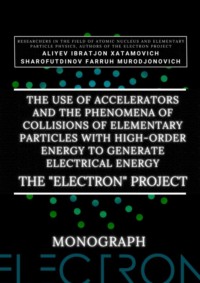
The use of accelerators and the phenomena of collisions of elementary particles with high-order energy to generate electrical energy. The «Electron» Project. Monograph

An important element also in calculations, this is also the total energy of massless particles, is the formula (2.21), where the conclusions of which are also given from the total energy ratio (2.17).

The notion of invariant also plays a role in this definition. An invariant is a constant value, regardless of the system of the report from which the observation is conducted. In this case, the invariant is the square of the mass or (2.22).

And it does not matter if it is a single particle or a system of particles, so the total energy E also refers to a particle or a system of particles, and the momentum of a particle also refers to a particle or a system of particles.
One of the most important points in the study of the physics of the atomic nucleus and elementary particles is familiarity with the system of units, which is the easiest way to perform calculations – this is the Gaussian system of units together with some non-system quantities.
Speaking of units of energy, due to the small amount of energy, it is convenient to use a unit of electron volts (eV), which is equal to 1.6 *10-19 J or 1.6 * 10-12 erg. This value represents the energy that an electron acquires by passing a potential difference of 1 Volt. Values of 1 keV (kiloelectronvolt) or 103 eV, 1 MeV or 106 eV, 1 GeV or 109 eV and 1 TeV or 1012 eV are also appropriate, which are actively used in the physics of elementary particles and the atomic nucleus.
As a unit of length or distance, it is customary to use the value of 1 Fermi (Fm) in honor of the famous scientist Enrico Fermi, which also coincides with the value of 1 femtometer (fm), where 1 Fm is 10-13 cm. As for the mass, it is expressed in energy units mc2, for example, the mass of an electron, which in the usual SI unit system is 9.11 * 10-28 grams, then in energy units is 0.511 MeV. And the mass of the proton, which is 1.6727 * 10-24 grams, in energy equivalent will be 938.27 MeV.
Special and general relativity have many effects, then 3 of them deserve more attention. The first of them is the time dilation for a relativistic particle, the second is the effect of shortening the distance in the direction of motion of a relativistic particle, and the third effect, which, by the way, comes out of general relativity – the time dilation in a gravitational field, also known as the gravitational redshift of radiation. For a better understanding of these effects, consider 3 cases.
Let some particles undergo decay according to the law of radioactive decay (2.23), where t0 is the lifetime at rest.

In this case, if the particles move at a certain speed, then their lifetime, due to time dilation, increases and becomes equal to (2.24), where the Lorentz factor is known (2.25) and from here it can already be said that the law of radioactive decay for relativistic particles is represented as (2.26).



Consider an example. Most of all the particles that fall to Earth together with cosmic radiation are protons with energies of the order of 1020 eV. At the same time, when they enter the Earth’s atmosphere, they collide with nitrogen and oxygen atoms, charged pions are born (some particles that have the designation π+ or π- for a positively and negatively charged pion, respectively), they decay in their free flight into already relativistic muons (other types of particles that are already designated as μ+ or μ- also for a positively and negatively charged muon, respectively), muon neutrinos vμ or their antineutrinos are also isolated from pions.And the lifetime of a peony is 2.6 * 10—8 seconds. Thus, a kind of «shower» of secondary particles is formed, which is born by a proton in the Earth’s atmosphere. And these reactions forming a «shower» can be written as (2.27), (2.28) and (2.29), and also illustrated in (Fig. 2.11).
Конец ознакомительного фрагмента.
Текст предоставлен ООО «ЛитРес».
Прочитайте эту книгу целиком, купив полную легальную версию на ЛитРес.
Безопасно оплатить книгу можно банковской картой Visa, MasterCard, Maestro, со счета мобильного телефона, с платежного терминала, в салоне МТС или Связной, через PayPal, WebMoney, Яндекс.Деньги, QIWI Кошелек, бонусными картами или другим удобным Вам способом.
Вы ознакомились с фрагментом книги.
Для бесплатного чтения открыта только часть текста.
Приобретайте полный текст книги у нашего партнера:
Всего 10 форматов